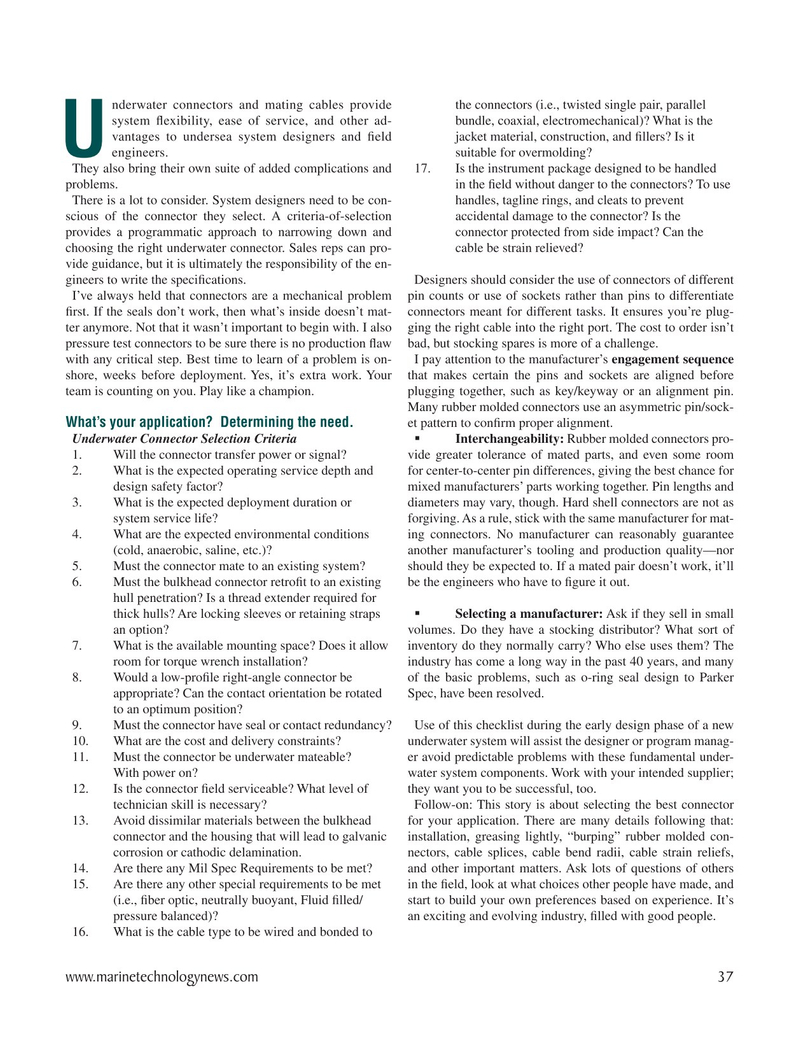
Page 37: of Marine Technology Magazine (May 2025)
Read this page in Pdf, Flash or Html5 edition of May 2025 Marine Technology Magazine
nderwater connectors and mating cables provide the connectors (i.e., twisted single pair, parallel system ? exibility, ease of service, and other ad- bundle, coaxial, electromechanical)? What is the vantages to undersea system designers and ? eld jacket material, construction, and ? llers? Is it
U engineers. suitable for overmolding?
They also bring their own suite of added complications and 17. Is the instrument package designed to be handled problems. in the ? eld without danger to the connectors? To use
There is a lot to consider. System designers need to be con- handles, tagline rings, and cleats to prevent scious of the connector they select. A criteria-of-selection accidental damage to the connector? Is the provides a programmatic approach to narrowing down and connector protected from side impact? Can the choosing the right underwater connector. Sales reps can pro- cable be strain relieved?
vide guidance, but it is ultimately the responsibility of the en- gineers to write the speci? cations. Designers should consider the use of connectors of different
I’ve always held that connectors are a mechanical problem pin counts or use of sockets rather than pins to differentiate ? rst. If the seals don’t work, then what’s inside doesn’t mat- connectors meant for different tasks. It ensures you’re plug- ter anymore. Not that it wasn’t important to begin with. I also ging the right cable into the right port. The cost to order isn’t pressure test connectors to be sure there is no production ? aw bad, but stocking spares is more of a challenge.
with any critical step. Best time to learn of a problem is on- I pay attention to the manufacturer’s engagement sequence shore, weeks before deployment. Yes, it’s extra work. Your that makes certain the pins and sockets are aligned before team is counting on you. Play like a champion. plugging together, such as key/keyway or an alignment pin.
Many rubber molded connectors use an asymmetric pin/sock-
What’s your application? Determining the need.
et pattern to con? rm proper alignment.
Underwater Connector Selection Criteria ? Interchangeability: Rubber molded connectors pro- 1. Will the connector transfer power or signal? vide greater tolerance of mated parts, and even some room 2. What is the expected operating service depth and for center-to-center pin differences, giving the best chance for design safety factor? mixed manufacturers’ parts working together. Pin lengths and 3. What is the expected deployment duration or diameters may vary, though. Hard shell connectors are not as system service life? forgiving. As a rule, stick with the same manufacturer for mat- 4. What are the expected environmental conditions ing connectors. No manufacturer can reasonably guarantee (cold, anaerobic, saline, etc.)? another manufacturer’s tooling and production quality—nor 5. Must the connector mate to an existing system? should they be expected to. If a mated pair doesn’t work, it’ll 6. Must the bulkhead connector retro? t to an existing be the engineers who have to ? gure it out.
hull penetration? Is a thread extender required for thick hulls? Are locking sleeves or retaining straps ? Selecting a manufacturer: Ask if they sell in small an option? volumes. Do they have a stocking distributor? What sort of 7. What is the available mounting space? Does it allow inventory do they normally carry? Who else uses them? The room for torque wrench installation? industry has come a long way in the past 40 years, and many 8. Would a low-pro? le right-angle connector be of the basic problems, such as o-ring seal design to Parker appropriate? Can the contact orientation be rotated Spec, have been resolved.
to an optimum position?
9. Must the connector have seal or contact redundancy? Use of this checklist during the early design phase of a new 10. What are the cost and delivery constraints? underwater system will assist the designer or program manag- 11. Must the connector be underwater mateable? er avoid predictable problems with these fundamental under- With power on? water system components. Work with your intended supplier; 12. Is the connector ? eld serviceable? What level of they want you to be successful, too.
technician skill is necessary? Follow-on: This story is about selecting the best connector 13. Avoid dissimilar materials between the bulkhead for your application. There are many details following that: connector and the housing that will lead to galvanic installation, greasing lightly, “burping” rubber molded con- corrosion or cathodic delamination. nectors, cable splices, cable bend radii, cable strain reliefs, 14. Are there any Mil Spec Requirements to be met? and other important matters. Ask lots of questions of others 15. Are there any other special requirements to be met in the ? eld, look at what choices other people have made, and (i.e., ? ber optic, neutrally buoyant, Fluid ? lled/ start to build your own preferences based on experience. It’s pressure balanced)? an exciting and evolving industry, ? lled with good people.
16. What is the cable type to be wired and bonded to www.marinetechnologynews.com 37
MTR #4 (34-47).indd 37 MTR #4 (34-47).indd 37 5/27/2025 2:54:45 PM5/27/2025 2:54:45 PM

 36
36

 38
38
